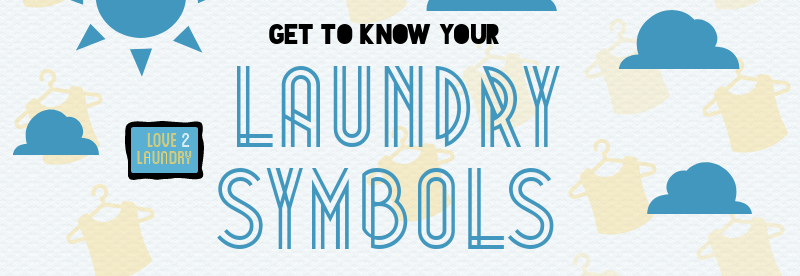
The Infographic Guide to Laundry and Washing Symbols
Welcome to the ultimate infographic guide to understanding washing symbols.
Most of us are excited to go shopping for brand new clothes. We imagine ourselves in them, and how we are going to feel wearing them. Right before you walk up to pay for your item at the register, you may quickly scan the tag for what sort of fabric was used, which size it is and … how to wash (the care label). But this is where many of us get stuck. We see a bunch of shapes we don’t understand and take a guess at how to clean our items.
When we see familiar laundry symbols like the outline of a tub with a number on it, we accurately assume we are supposed to clean our clothes, but not everyone knows which washing machine settings they are supposed to apply.
Matter of fact, before you continue reading, why not stop to try and come up with all the laundry symbols you have memorised off the top of your head?
Depending on the modifications to the laundry symbol you examine, you may be damaging some of your favourite garments. But not anymore. In this article, we will cover the most common washing, bleaching, drying, ironing and professional cleaning symbols. Take the time to review every care label as each represents a different action which will help prolong the life of your fabrics.
Your most recent load of laundry could be the last time you will have to worry about shrinking or breaking your clothes.
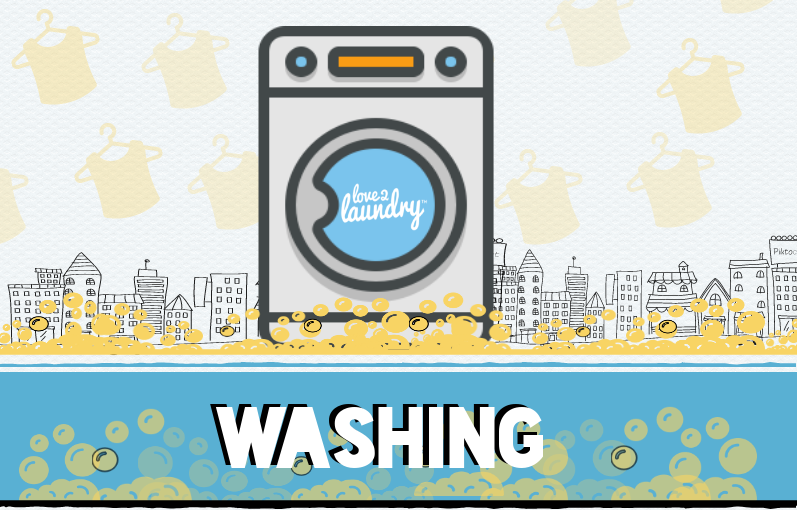
WASHING Symbols
About time you learned how to sort out your load of laundry, more thoroughly than setting whites and colours aside. Some of your bedding, garments and fabrics require a bit more attention. We are going to go over the laundry care labels you are most likely to encounter. As per washing symbols, the most important image to look out for is that of an outlined washtub.
Washing: A washtub without a number at the centre means you may wash your item in the washing machine. You may decide your preferred wash cycle.
Wash at or below 30°C: A washtub with the number ‘30’ at the centre is an indicator that you may wash your item in the machine at a maximum temperature of 30 degrees.
Wash at or below 40°C: A washtub with the number ‘40’ at the centre is an indicator that you may wash your item in the machine at a maximum temperature of 40 degrees.
Wash at or below 50°C: A washtub with the number ‘50’ at the centre is an indicator that you may wash your item in the machine at a maximum temperature of 50 degrees.
Wash at or below 60°C: A washtub with the number ‘60’ at the centre is an indicator that you may wash your item in the machine at a maximum temperature of 60 degrees.
Hand wash: When you come across a washtub with the outline of a hand inside, you are probably scanning the care symbol of a delicate item. Wash these items by hand or a very gentle cycle on your washing machine at a low-temperature.
Do not wash: A crossed out washtub signifies that you should not wash your item.
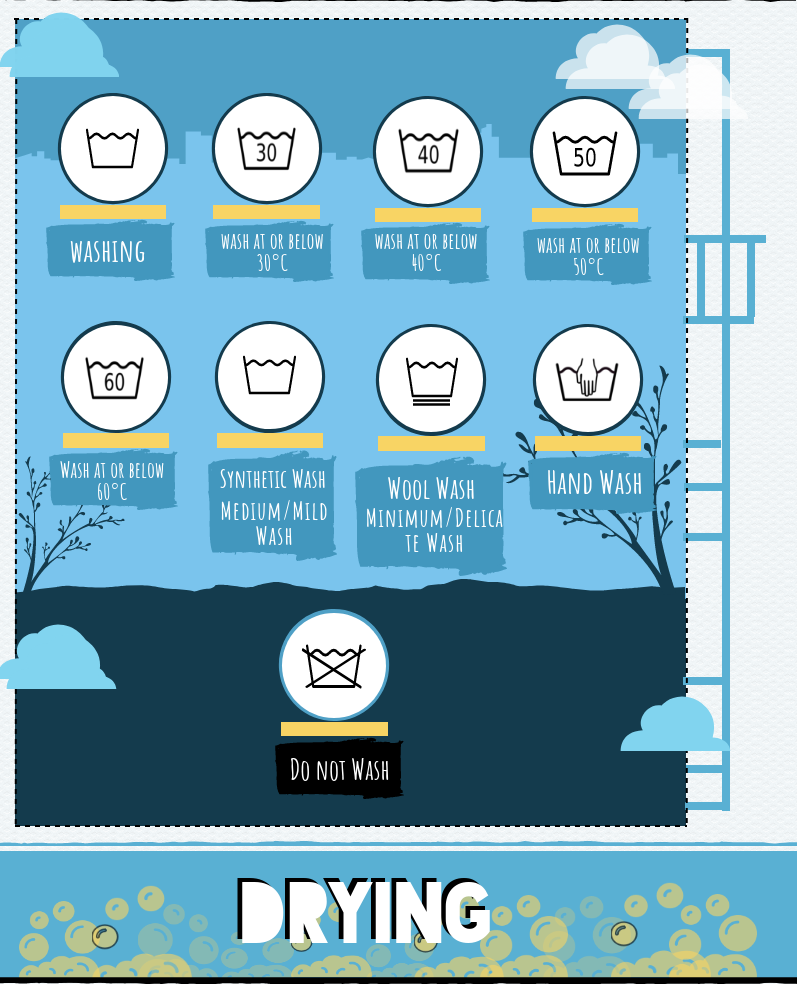
DRYING Symbols
The easiest way to spot a care label related to drying is to look out for a square. Squares will be featured to represent both types of drying which may be applied to various fabrics: natural drying and tumble drying.
Natural Drying
Drying symbol: A simple square asks you to keep your items away from washing machines. They are intended to be dried naturally.
Line dry: A curved line connected to the upper left and right corner of a square asks you to dry your item naturally on a clothesline.
Dry flat: A square with a horizontal line located at the centre of a square tells you to dry your item naturally while laying it out flat. Some items may lose their shape if you leave them to dry while hanging. Follow the label recommendation, and you won’t have to worry about stretching out your sweaters or knitted garments.
Drip dry: A square with three vertical parallel lines indicates that your item ought to be drip dried. Otherwise, your fabric will crease.
Dry in the shade: The symbol is represented by two parallel and slanted lines in the upper left-hand corner of a square. It asks you to naturally dry your item while keeping it away from exposure to the sun.
Line dry in the shade: This laundry care label is portrayed by two parallel and slanted lines in the upper left-hand corner, and a curved line connected to the upper left and right corner of a square.
Dry flat in the shade: When you see a square with two slanted parallel lines at the upper left-hand corner, PLUS a horizontal line at the centre, it means your item ought to be kept away from the sun. You also ought to lay out your item, so it is flat to preserve its quality.
Drip dry in the shade: This laundry care symbol is represented by a square, two slanted parallel lines at the upper left-hand corner, PLUS three horizontal line at the centre. It will also crease or shrink them if you hang or tumble dry them.
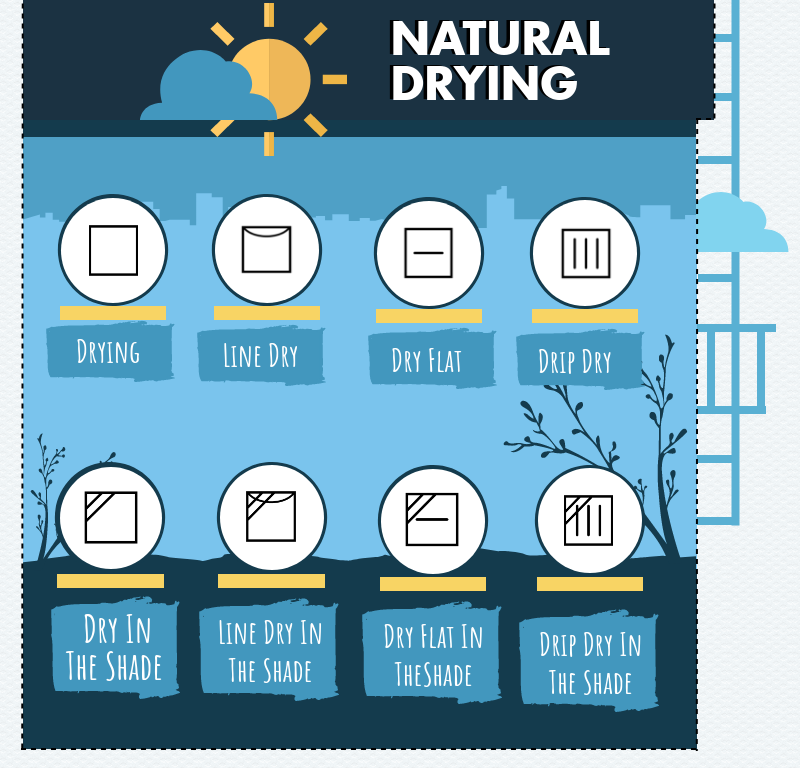
Tumble Drying
You may easily distinguish between natural drying care symbols and their tumble dry equivalent by identifying the circle enclosed by a square.
Tumble drying symbol: A circle enclosed in a square is the laundry symbol for tumble drying. It means your item is washing machine friendly and you may choose whichever setting suits you.
Low heat tumble drying: When you see a square surrounding a circle with a dot at the centre, it means you ought to wash your item at a low temperature otherwise you may damage it.
Normal heat tumble drying: This laundry symbol is illustrated by two dots which lie at the centre of the circle enclosed by a square.
Do not tumble dry: A crossed out circle and square asks you to keep your item away from your washing machine, it is not intended to be tumble dried.
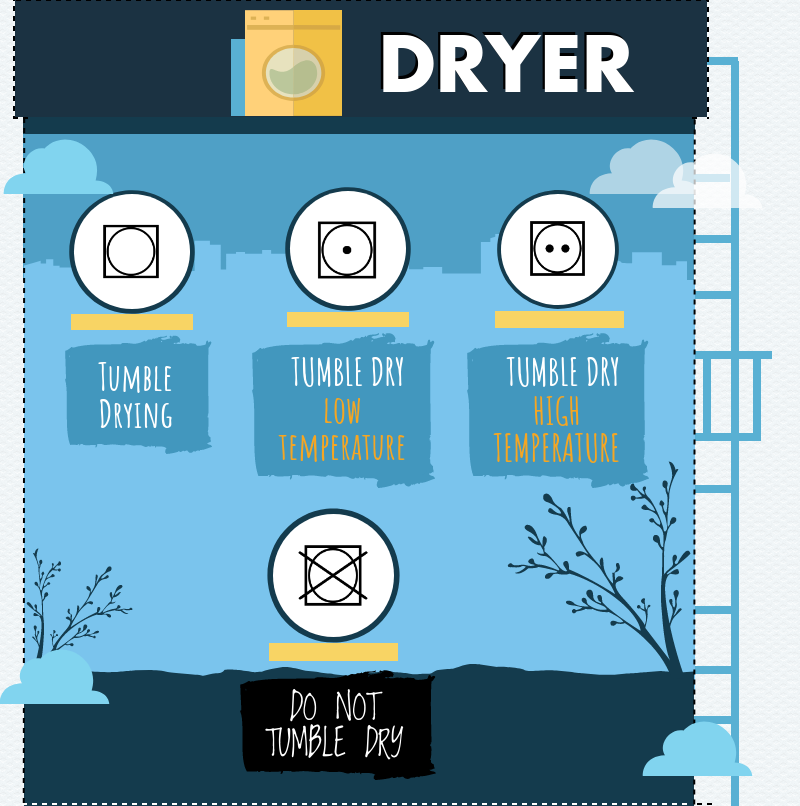

IRONING Symbols
Ironing care labels are relatively more straightforward to remember. The outline of an iron is used to advise individuals as to the best ironing practices for their fabrics.
Ironing symbol: The outline of an iron which lets people know they may iron their item as they see fit. There is no recommended ironing temperature.
Iron at low temperature: Usually reserved for delicate fabrics like silk, you will find a single dot at the centre of an iron.
Iron at medium temperature: Typically found on your synthetic fabrics, the two dots in the middle of an iron as you to press your clothes at a medium temperature.
Iron at high temperature: Three dots at the centre of an iron asks you to iron your item at a high temperature.
Do not iron: The crossed out outline of an iron warns you against ironing your clothes.
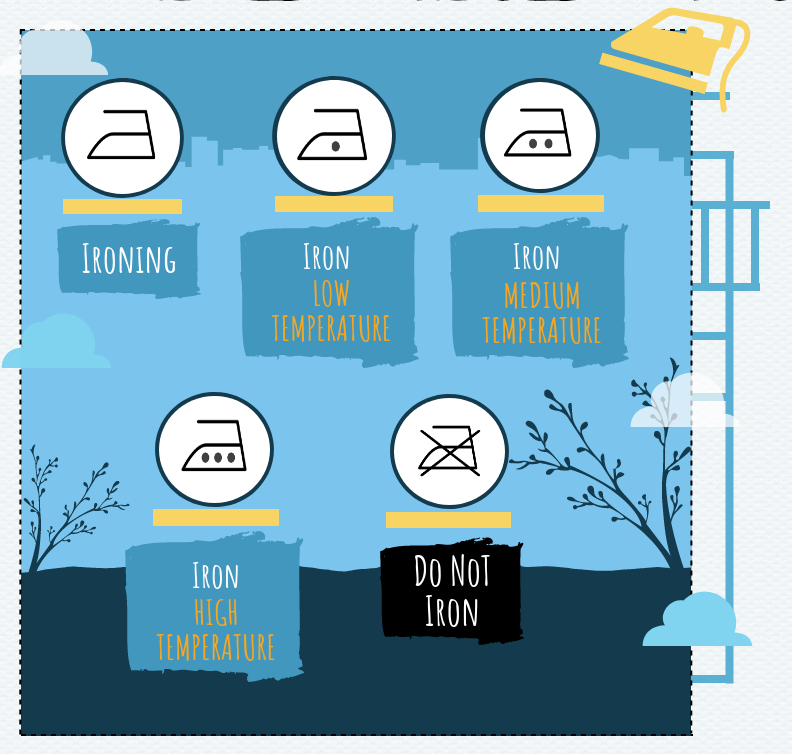
BLEACHING Symbols
Bleaching care symbols are intended to direct you as to what sort of bleach you may apply to your garments. Your demonstrated options will be between the use of chlorine or non-chlorine solutions.
Bleaching symbol: The standard bleaching symbol is represented by a simple triangle which indicates that the particular fabric may be bleached with the use of chlorine and non-chlorine solutions.
Bleaching with chlorine allowed: This recommendation is portrayed by a triangle which surrounds the abbreviation, CL. The CL represents chlorine, indicating to the owner that both chlorine and non-chlorine solutions can be used. You may find this symbol on older items as the standard triangle is usually adopted in place of this one.
Non-chlorine bleach when needed: Two parallel lines cutting across a triangle tells you that you may bleach with non-chlorine solutions.
Do not bleach: A crossed out darkened/non-darkened triangle explicitly asks you not to bleach.
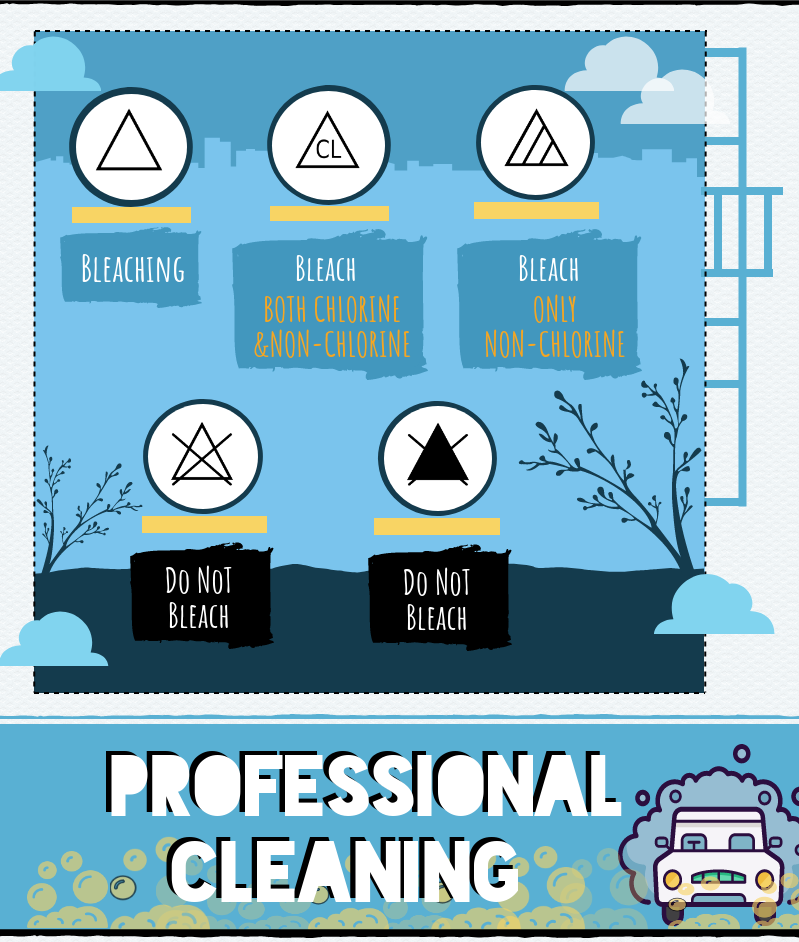
PROFESSIONAL CLEANING Symbols
You would probably refer to professional cleaning as dry cleaning. And even though you will tend to hand these items over to trained laundry specialists, it may come in handy to know what is happening to your suits and expensive jackets while they are being cleaned.
Professional cleaning generally falls into two categories: chemical cleaning and wet cleaning. Both are depicted by a circle. The letters ‘F’ and ‘P’ are used to describe chemical washes while the letter ‘W’ signifies a wet clean.
The more bars you find underneath your laundry symbols is a signal for a more gentle wash.
Chemical Cleaning
Professional cleaning symbol: A circle indicates that you ought to trust your item to a specialist.
Dry clean, hydrocarbon solvent only (HCS): This type of wash is represented by the letter ‘F’ enclosed by a circle. The ‘F’ tells your laundry specialist to clean your item with hydrocarbon solvents only.
Gentle cleaning with hydrocarbon solvents: You will find the letter ‘F’ enclosed by a circle and bar underneath.
Very gentle cleaning with hydrocarbon solvents: This symbol is typified by letter ‘F’ enclosed by a circle and a double bar underneath.
Dry clean, any solvent except tetrachloroethylene: This care label features a letter ‘P’ enclosed by a circle. The ‘P’ is the shortened version of the abbreviation PCE which stands for the solvent, tetrachloroethylene. The ‘P’ asks your laundry professional to clean your item with any cleaning solution EXCEPT tetrachloroethylene.
Gentle cleaning with PCE: You will find the letter ‘P’ enclosed by a circle with a bar underneath.
Very gentle cleaning with PCE: You will see the letter ‘P’ enclosed by a circle with a double bar underneath.
Do not dry clean: A crossed out circle indicates that you are not to dry clean your fabric.
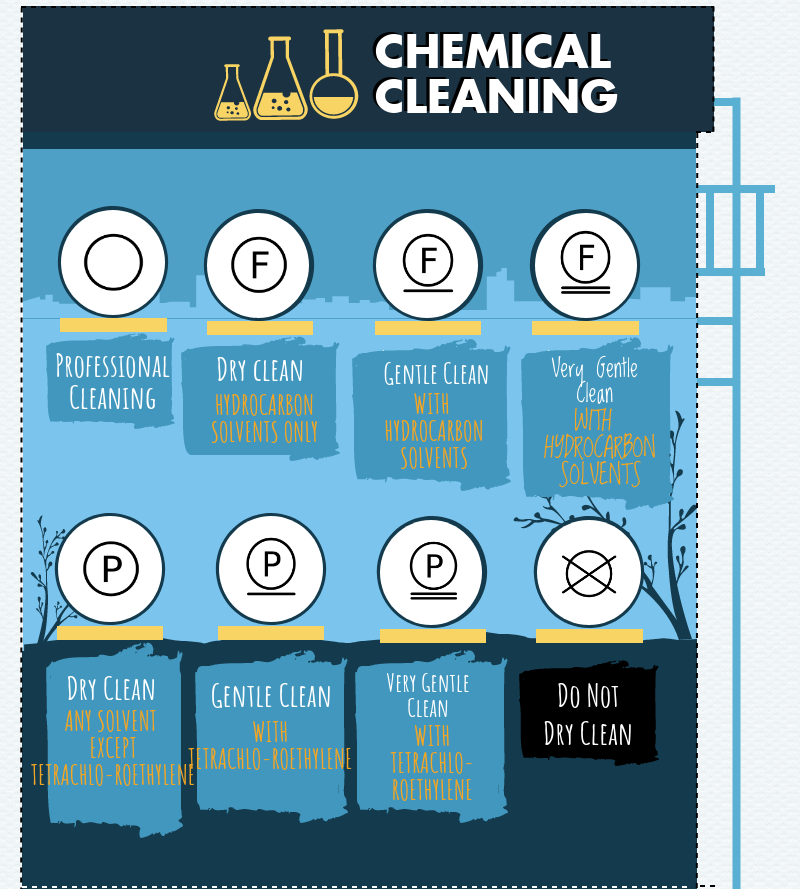
Wet Cleaning
Professional wet cleaning: The care label is represented by a circle with the inscription ‘W.’ The letter stands for WET CLEANING.
Gentle wet cleaning: We see the line again underneath the ‘W’ enclosed by a circle.
Very gentle wet cleaning: The ‘W’ enclosed by a circle sits above two lines, indicating a more gentle type of clean than above.
Do not wet clean: A black circle is cancelled out to help differentiate between the ‘do not dry clean’ symbol.

At this point, you have either become the master of care labels, or you have become overwhelmed. There are quite a few laundry care labels to keep up with. Regardless of which side you fall on, Love2laundry is here to take care of your laundry needs.
We know every care label, backwards and forwards. And your satisfaction is our number one priority. Not only will we translate your laundry symbols into expert care, but we will also pick up your dirty laundry from your door. Contact us today to learn how we deliver your cleaned, ironed and folded items back to you within 24 hours.
We look forward to hearing from you.
Enjoy the full Infographic Below! Share this Image On Your Site






